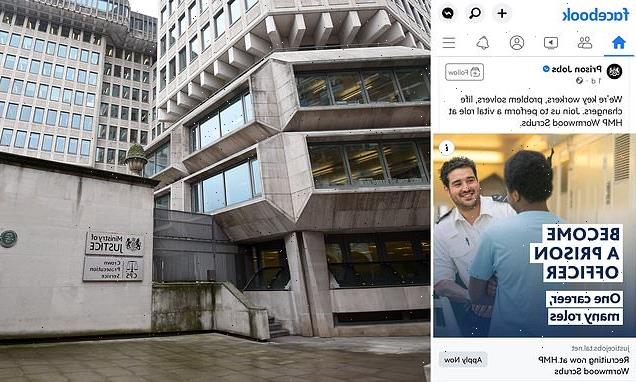
Ministry of Justice ad that featured a white guard talking to a black prisoner is banned by Facebook for being RACIST
- The ad for the MoJ’s Prison Jobs scheme was seen on Facebook on June 25
- A reader complained that the ad perpetuated negative ethnic stereotypes
- MoJ said the photos used in the campaign featured real officers and prisoners
A Facebook ad for the Ministry of Justice (MoJ) that featured a white guard talking to a black prisoner has been banned for being racist.
The ad for the MoJ’s Prison Jobs scheme, seen on June 25, included superimposed text stating: ‘Become a prison officer. One career, many roles.’
A caption accompanying the image read: ‘We’re key workers, problem solvers, life changers. Join us to perform a vital role at HMP Wormwood Scrubs.’
A reader complained that the ad perpetuated negative ethnic stereotypes and was likely to cause serious offence.
The MoJ, which confirmed it would appeal the ruling, said the photographs used in the ad campaign featured real officers and prisoners, arguing that it did not therefore ‘portray’ a black man as a criminal but rather depicted a real person who had been convicted of an offence.
It said it was not an inaccurate or unfair representation of the type of engagement that might have been seen between officers and prisoners.
The ad (pictured) for the MoJ’s Prison Jobs scheme, seen on June 25, featured an image of a white prison officer talking to a black inmate, with superimposed text stating: ‘Become a prison officer. One career, many roles.’
The MoJ said the image formed ‘one small part’ of the overall campaign – accounting for less than 5 per cent of its spending on the ads – ‘which used a wide variety of images and showed officers of different ethnicities, interacting with each other’.
It added that none of the other images used in the Facebook part of the campaign showed white officers alongside ethnic minority prisoners.
The Advertising Standards Authority (ASA) noted that the ad formed part of an overall campaign that used images of prison officers and other prison staff from a number of different ethnic backgrounds, but said it assessed the post as it would have appeared to consumers on Facebook.
The ASA said: ‘The ad showed a real white prison officer and black male inmate in a prison setting.
‘The inmate wore an afro pick comb in his hair – a tool we understood was uniquely associated with black culture.
‘The ad made reference to prison officers being “problem solvers” and “life changers”, and we considered it drew a link between the officer depicted and those attributes.
The MoJ (above), which confirmed it would appeal the ruling, said the photographs used in the ad campaign featured real officers and prisoners, arguing that it did not therefore ‘portray’ a black man as a criminal but rather depicted a real person who had been convicted of an offence
‘On the other hand, the black prisoner was depicted as a criminal, without those positive attributes.
‘We considered the ad did not suggest that all black men were criminals or were more likely to be so than any other ethnic group.
‘However, it showed an imbalanced power dynamic, with a smiling white prison officer, described as a “life changer”, and a black, institutionalised prisoner.
‘We considered the ad’s focus on the positive qualities of the white prison officer and negative casting of the black prisoner was likely to be seen as perpetuating a negative racial stereotype.
‘We concluded that the ad was likely to cause serious offence on the grounds of race by reinforcing negative stereotypes about black men.’
The ASA ruled that the ad must not appear again, adding: ‘We told the Ministry of Justice to ensure they avoided causing serious offence on the grounds of race.’
An MoJ spokeswoman said: ‘We will be appealing this ruling.
‘This was one of a wide range of different images used in an advertising campaign featuring real situations in prison – which is an essential part of attracting the right candidates.’
Source: Read Full Article

